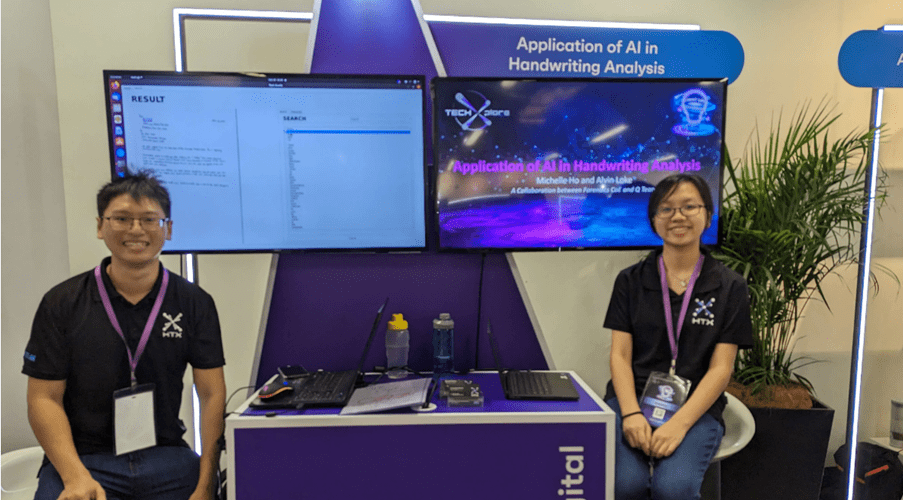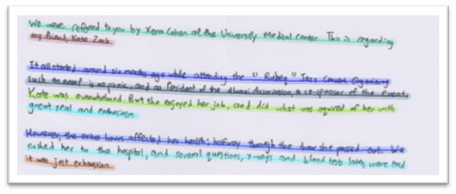HTX has developed TextOracle, an AI-powered solution to improve the forensic handwriting examination process.

Michelle Ho from Forensics CoE (right) and Q Team’s Alvin Loke (left) exhibiting TextOracle at last year’s TechXplore 5 (Photo: HTX)
A dead body is discovered, and a handwritten suicide note is found beside it. Was this note written by the dead person? Or was it a murder, and the suicide note a forgery intended to cover up the killing?
This is a situation where forensic document examiners can help uncover the truth. These experts have the skills to examine the handwriting on documents such as wills, threat letters, and suicide notes, compare them with samples of the person’s known specimen handwriting, and determine if the documents were really written by the person, or if they were forged by someone else.
How do forensic examiners accomplish this task? The document in question and the known specimen writing of the person are analysed. Handwriting features are compared between them, and the significance of their similarities and differences evaluated. As part of the handwriting examination process, a comparison chart is produced using the images of comparable letters or words from these two types of documents to better illustrate the handwriting features.
While this method can identify whether a document is authentic or a forgery, it is manual and extremely time-consuming. Depending on the volume of documents involved, it can even take days or weeks to complete. Could there be a faster and more efficient way to do this analysis?
Forensic scientist Michelle Ho and her colleagues from Forensics Centre of Expertise have spent 18 months collaborating with Q Team on Project HAI-TextOracle, a joint project to deploy Artificial Intelligence (AI) to improve the forensic handwriting examination process.
Samples of writing from the text that is suspected to be a forgery and a sample of text that is known to be authentic are first scanned and uploaded into TextOracle. The program will identify and extract images of individual words, and automatically label the images with the line and word numbers of the scanned text.
 TextOracle can automatically identify line segments in a handwritten text. (Photo: HTX)
TextOracle can automatically identify line segments in a handwritten text. (Photo: HTX)
 In each line segment, TextOracle can identify specific blocks of handwritten text. (Photo: HTX)
In each line segment, TextOracle can identify specific blocks of handwritten text. (Photo: HTX)
 TextOracle can identify the word represented by each block of handwritten text. This is important as forensic document examiners can search for specific words in the suspect and authentic writing specimens to compare their handwriting features.
(Photo: HTX)
TextOracle can identify the word represented by each block of handwritten text. This is important as forensic document examiners can search for specific words in the suspect and authentic writing specimens to compare their handwriting features.
(Photo: HTX)
Forensic document examiners can easily use the search function in TextOracle to search for words of interest and compare their handwriting features. Instead of days or weeks needed to manually generate the comparison chart, TextOracle can complete the task in just hours or days!
TextOracle is still work in progress. The system currently has an accuracy rate of 85% for recognising neat, regular handwriting, but only 60% success rate for cursive handwriting. The TextOracle developers are working to improve the system’s accuracy in identifying all forms of handwriting.
Michelle presented TextOracle at the 23rd Triennial Meeting of the International Association of Forensic Sciences (IAFS) held in Sydney, Australia, from 20-24 November 2023. This was a major event attended by over 1,700 forensic experts from 70 countries, and she impressed her audience with her sharp and focused presentation of how TextOracle can help forensic document examiners save time in the document comparison process. Her presentation was very well received and she was awarded the Best Oral Presentation award in the field of Document Examination!
This project won the 2024 Home Team InnovA Dare-To-Try award.

